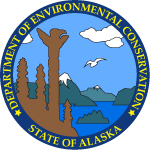| Action Date |
Action |
Description |
DEC Staff |
| 7/27/2009 |
Site Added to Database |
A new site has been added to the database |
Deborah Williams |
| 8/31/2009 |
Update or Other Action |
Notice to proceed was awarded to Hoefler through SPAR term contract. Project managed under Reuse and Redevelopment Program. |
Deborah Williams |
| 10/13/2009 |
Meeting or Teleconference Held |
DEC held a stakeholder meeting for ADOT&PF Port Heiden Airport. The participants of the meeting included representatives from DOT (Tina Schimschat and Jennifer Kuentzel), Hoefler (consultants for this project)(Jessica Adema and Phil Barnes) and from DEC (Deborah Williams, Sonja Benson and John Carnahan). The purpose of this meeting was to discuss the plans for the work to be completed at the site (Property Assessment and Cleanup Plan) and give the consultants an opportunity to ask any questions of the landowner. |
Deborah Williams |
| 10/27/2009 |
Site Visit |
Hoefler, consultant for DEC, conducted a site visit of the ADOT&PF Port Heiden Airport to collect information for the property assessment and cleanup plan. |
Deborah Williams |
| 7/30/2010 |
Update or Other Action |
Received a draft Property Assessment and Cleanup Plan (PACP) for the ADOT&PF Port Heiden Airport site. Soils samples collected east of the former warehouse from fuel stains in the surface soil 0 to 2 feet bgs contained DRO up to 20,300 mg/kg, RRO up to 51,500 mg/kg, naphthalene up to 0.458 mg/kg, and 1-methylnapthalene up to 1.15 mg/kg. Below are the recommendations from Hoefler, based on the 2009 PACP, on actions necessary to bring the Port Heiden Airport property to a condition suitable for reuse:
• Investigate surface soils adjacent to the pad area to determine if PCBs are a COC at the site (Hoefler recommends up to ten surface and near surface soil samples should be collected at the area adjacent to the concrete pad. They recommend analyzing the samples for PCBs (Aroclor 1260 and total PCBs), GRO, BTEX, DRO and RRO). A rough estimate of the total volume of potentially PCB-contaminated material that may require offsite disposal is approximately 90 cubic yards;
• Perform a groundwater sampling event to determine if contaminants in the groundwater are continuing to naturally attenuate;
• Excavate contaminated soil north of the pad (approximately 0.5 cubic yards) and spill cleanup on the pad (associated with a leaking drum on the southeast corner of the pad);
• Dispose of petroleum product containing drums via energy recovery or offsite disposal;
• Recycle universal waste (lead acid batteries);
• Dispose miscellaneous equipment and debris; and
• Implement institutional controls at the site to alert site workers and site users to avoid contact with groundwater.
A rough cost estimate for additional characterization, excavation and disposal of contaminated soils, cleanup and disposal of the pad spill, and waste and debris disposal is $113,836. This estimate assumes:
• Excavation and offsite disposal of 90 cy of PCB-contaminated soil;
• Approximately 0.5 cy of petroleum-contaminated soil can be managed in Port Heiden through landspreading;
• Offsite disposal of hazardous debris (off spec used oil, lead batteries, GAC filter drums, compressed gas cylinders, and spent sorbent used during the pad cleanup) and large debris items (empty chemical totes) utilizing a waste backhaul program;
• Onsite disposal of smaller and unregulated waste items in the Port Heiden Class III landfill; and
• The community of Port Heiden would assume responsibility of burning used oil appropriate for energy recovery.
|
Deborah Williams |
| 11/24/2014 |
Update or Other Action |
Reviewed file and coordinated with IC Unit and DOT to seeking an update in the site status. Reiterate that contamination was identified and may require further assessment or clarification. |
John Carnahan |
| 11/8/2016 |
Update or Other Action |
Letter sent on this day outlining the site history and existing data gaps. |
Joshua Barsis |
| 1/23/2019 |
Document, Report, or Work plan Review - other |
Reviewed the report: Groundwater Monitoring, dated December 7, 2018. The report describes the groundwater monitoring activities completed in October of 2018. Only 3 of the 13 monitoring wells planned for sampling were located (MW7, MW22, and MW39); however, an additional 3 wells (MW4, MW11, and MW18) were also located. All other wells are presumed destroyed. Samples were collected from all 6 wells and were submitted for laboratory analysis of DRO, RRO, VOCs, and PAHs.
Sample results from Wells MW18 and MW22 exceeded the Table C groundwater cleanup levels for several petroleum related constituents, including DRO, benzene, ethylbenzene, xylenes, naphthalene, and various others.
|
Joshua Barsis |
| 7/15/2020 |
Document, Report, or Work plan Review - other |
On this date, ADEC received the Final Work Plan for Additional Characterization and Monitoring well decommissioning, Lot 1A, Block 100. Ten test pits will be advanced, and up to three monitoring well installed in the test pits. Additionally, and remaining potential source areas will be documented. |
Grant Lidren |
| 11/4/2020 |
Update or Other Action |
DEC was contacted by the DOT. The consultants are in the field, but are being told there is a buried electric wire in one of the areas where test pits were to be dug. Ground is also frozen down to 6 inches. Discussed options for soil sampling in areas of staining. |
Janice Wiegers |
| 3/19/2021 |
Document, Report, or Work plan Review - other |
Reported dated February 5, 2021 titled Additional Site Characterization & Monitoring Well Decommissioning was reviewed on this date. The field event included decommissioning of wells MW-4, MW-7, MW-11, MW-18, MW-22, and MW-39. Project activities also consisted of advancing one test pit, and
collecting soil samples. The original workplan included advancing ten test pits and the installation of three monitoring wells in select pits but the presence of buried utilities and metals drums/debris did not allow all intended site work including the installation of monitoring wells. The sampling data that was obtained showed arsenic concentrations which exceeded the most stringent ADEC Method Two cleanup levels. They were detected in duplicate samples TP1S5/TP1S15. These concentrations are consistent with background arsenic concentrations. The remaining tested analytes were either not detected or were reported at concentrations less than the ADEC cleanup levels. This site record will need to be reviewed to determine the need for the test pit and groundwater data which was not obtained during this event.
|
Evonne Reese |
| 5/28/2021 |
Document, Report, or Work plan Review - other |
On this date ADEC received the Revised Work Plan for Additional Site Characterization Activities, Lot 1A, Block 100, Port Heiden Airport, Port Heiden, Alaska ADEC File No. 2637.57.002 dated May 28, 2021. The work plan proposes advancing nine hand soil borings from which soil samples will be collected. The soil borings will be advanced adjacent to the concrete slab located adjacent to the former warehouse. Soil boring depths will be advanced to approximately 3 to 5 feet below ground surface. If evidence of contamination is observed up to four step-out hand borings will be advanced. One analytical soil sample will be collected from each hand boring from the interval with the highest PID reading or visual and/or olfactory evidence of contamination. Changes to the work plan include visually observing the ground surface in the vicinity of the former warehouse structure for staining or other potential environmental concerns and documenting these concerns, and analyzing the three samples with the highest PID readings for gasoline range organics (GRO), volatile organic compounds (VOCs), and polynuclear aromatic hydrocarbons (PAHs) in addition to diesel range organics (DRO), residual range organics (RRO), and polychlorinated biphenyls (PCBs). |
Brandi Tolsma |
| 10/11/2021 |
Document, Report, or Work plan Review - other |
On this date, ADEC received report for the additional site characterization activities conducted at the Port Heiden Airport. The report details the July 2021 additional site activities conducted at Lot 1A, Block 100, Port Heiden Airport. Activities consisted of advancing 12 hand borings and collecting soil samples. The soil samples collected from the hand borings advanced adjacent to the concrete slab did not contain contaminant concentrations exceeding the ADEC Method Two cleanup levels. Soil samples collected from Hand Boring HB6, which was advanced in the location of former Sample PHASS03, contained concentrations of DRO exceeding the ADEC Method Two migration to groundwater and human health cleanup levels. Step-out Hand Borings HB8 and HB9, advanced east and south, respectively, of Hand Boring HB6 also contained concentrations of DRO exceeding the ADEC Method Two migration to groundwater cleanup. The vertical extent of DRO contamination is not fully delineated in this area. In addition, the horizontal extent of contamination is not fully delineated to the east/southeast of Hand Boring HB8. The ADEC recommends further investigation of the area surrounding HB6, HB8, and HB9 to determine the horizontal and vertical extent of contamination including characterization of potential impacts to groundwater. |
Brandi Tolsma |
| 12/17/2021 |
Meeting or Teleconference Held |
Meeting with RP and consultant held to discuss cleanup options at Port Heiden Airport, Block 1A, Lot 100. |
Brandi Tolsma |
| 8/18/2022 |
Document, Report, or Work plan Review - other |
On this date, DEC approved work plan. The work plan proposes excavating the area that
encompasses hand borings HB6, HB8, and HB9, collecting soil samples from the excavation base and
sidewalls, installing and sampling a monitoring well in the area of the excavation, and landfarming
excavated soil. Soil and groundwater samples will be analyzed for diesel range organics (DRO),
residual range organics (RRO), polycyclic aromatic hydrocarbons (PAHs), volatile organic compounds
(VOCs), and PCBs. |
Brandi Tolsma |
| 1/13/2023 |
Document, Report, or Work plan Review - other |
On this date, ADEC approved the report titled "Additional Site Characterization and Cleanup Activities, Lot 1A, Block 100, Port Heiden Airport, Port Heiden, Alaska; ADEC File Numbers 2637.26.002 and 2637.57.002” dated December 2022.The report details the September 2022 additional site characterization and cleanup activities conducted at Lot 1A, Block 100, Port Heiden Airport. Activities consisted of excavation and landfarming activities, installing groundwater monitoring well MW1, and collecting analytical soil and groundwater samples. Approximately 130 cubic yards of soil were excavated from the approximate location of Hand Borings HB6, HB8, and HB9 and transported to the proposed landfarm location. Seven excavation analytical samples were collected from the locations of the highest PID readings. Monitoring well MW1 was placed in the excavation, developed, and sampled for diesel range organics (DRO), residual range organics (RRO), volatile organic compounds (VOCs), and polynuclear aromatic hydrocarbons (PAHs).
Analytical results for the excavation soil samples, baseline soil samples, and groundwater samples were below all applicable ADEC cleanup levels. In order for this site to be granted a cleanup complete designation, additional sampling of MW1 will be required and post-treatment sampling of the landfarmed soils will be required to ensure cleanup standards have been met. |
Brandi Tolsma |
| 7/15/2024 |
Document, Report, or Work plan Review - other |
DEC approved the workplan titled "Work Plan for Landfarm and Groundwater Sampling". The project will consist of groundwater and landfarm sampling activities, managing investigation-derived waste (IDW), and reporting. To account for seasonal variability, Monitoring Well MW1 will be sampled in the
spring/early summer and fall 2024. One analytical groundwater sample will be collected from the monitoring well during each sampling event and analyzed for DRO by Alaska Method (AK) 102, residual
range organics (RRO) by AK 103, VOCs by Environmental Protection Agency (EPA) Method
8260D, and polynuclear aromatic hydrocarbons (PAHs) by EPA Method 8270D SIM.
During the fall 2024 groundwater sampling event, Shannon & Wilson will collect posttreatment field screening and analytical soil samples from the landfarm and beneath the landfarm. Five analytical samples will be collected from the locations with the highest headspace readings. In addition, four spatially representative analytical samples will also be collected from beneath the landfarm. The soil samples will be analyzed for DRO by AK 102. IDW will consist of purge water from Well MW1. Groundwater generated during sampling efforts will be run through a granular activated carbon (GAC) filter and discharged on site. |
Mollie Dwyer |




